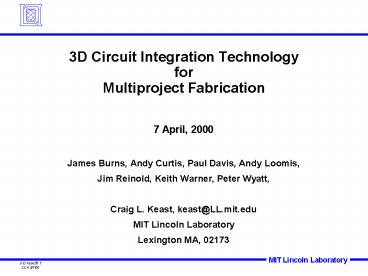3D Circuit Integration Technology for Multiproject Fabrication PowerPoint PPT Presentation
Title: 3D Circuit Integration Technology for Multiproject Fabrication
1
3D Circuit Integration Technologyfor
Multiproject Fabrication
- 7 April, 2000
- James Burns, Andy Curtis, Paul Davis, Andy
Loomis, - Jim Reinold, Keith Warner, Peter Wyatt,
- Craig L. Keast, keast_at_LL.mit.edu
- MIT Lincoln Laboratory
- Lexington MA, 02173
2
Outline
- Background
- Motivation for 3-D technology
- Why Multiproject Fabrication?
- Leveraging the FDSOI CMOS technology base
- Current Status
- Photodiode process development
- 3-D technology transfer
- Wafer Aligner/Bonder purchase
- 3-D Via topologies
- Summary
3
3-D Circuit Technology
- General Objective
- Break away from the traditional 2-D-constrained
Moores Law scaling trends by developing and
demonstrating a robust, high density, vertical
chip-to-chip interconnection technology and
making it available to the DoD and research
community through multiproject runs - Program Description (Joint effort with TREX
Enterprises) - Develop enabling technologies for 3-D integration
- Precision wafer-to-wafer overlay
- Low temperature wafer-to-wafer oxide bonding
- High density wafer-to-wafer electrical
interconnects - Demonstrate the 3-D technology by fabricating a
high definition 3-layer imaging module - Put in place infrastructure to allow for 3-D
multiproject fabrication
4
Motivation 3-D Circuit Technology
- Better circuit / interconnect ratio
- Unrestricted vertical interconnections between
layers - Low digital system power PCV2f
SOI CMOS
3D
5
3-D Interconnect Demonstration Vehicle(Fully
Parallel 64 x 64 APS Imager with A/D Conversion)
A/D Converter Circuits fabricated in 1-mm thick
SOI CMOS
Active Pixel Imaging Circuits fabricated in
10-mm thick SOI CMOS
6
3-D Process FlowBack Metal Interconnect
7
Developing 3-D Multiproject Infrastructure
- Transfer to, enhance and stabilize all aspects of
the 3-D fabrication process in Lincolns
Microelectronics Laboratory - Initial program effort had different parts of the
3-D fabrication process being performed at three
different locations - Starting circuit layer fabrication MIT Lincoln
Laboratory - Wafer transfer and bonding Kopin Corporation
- 3-D via etch and metallization Northeastern
University - Demonstrate 3-D circuit technology by fabricating
a three-layer high definition imaging module
SOI CMOS signal processing (layer 3)
SOI CMOS A/D Converter (layer 2)
Imaging Layer (layer 1)
Thinned Bulk Si Wafer
Backside illumination
8
Motivation3-D Multiproject Fabrication
- Mainstream silicon technology continues to focus
on 2-D centered technologies - This approach will probably continue for another
10 years unless something revolutionary
happens - This is the low risk path, lots of inertia in the
system - Maximizing the potential of 3-D system
architecture requires a new thought process - We need to get a group of talented individuals
and/or teams thinking about the
design/architecture issue as it relates to
specialized DoD and potential commercial system
needs - This thinking needs to be focused in the context
of a realizable 3-D technology
9
Motivation3-D Multiproject Fabrication (cont.)
- The 3-D Multiproject Fabrication model provides
the vehicle to explore the potential of 3-D
system integration across a broad research
interest base - Putting in place a user friendly streamlined
3-D integration technology built upon - Aggressive low power, high performance SOI CMOS
technology - Robust oxide-based wafer bonding technology
- Precision wafer-to-wafer alignment technology
- Provides the opportunity to explore mixed
function (MEMS, CMOS, CCD, etc.) and mixed
material (Si, SiGe, GaAs, etc.) system
integration - Builds upon Lincoln Laboratorys past
Multiproject Run experience and core process
technologies already in place and under
development at the Laboratory
10
Low Power, High Performance FDSOI CMOS Roadmap
MUMS3 Ship 6/14/99
MUMS2 Ship 7/15/98
Baseline 0.25 mm SOI/CMOS
MUMS4 Start 1/1/00
0.175 mm SOI/CMOS
Merged CCD/CMOS
DoD/AST
MUMS3.5 Start 2/1/99
LVA1 Start 4/1/00
LVA2 Start 11/1/00
Low Voltage Analog
DoD/RT
3-D Stacking Technology
DARPA/ARMY
Honeywell/LM
Damascene Waveguides 3-D Layer Stacking RF
MEMS Precision-MCM-D FDSOI CMOS InGaAs Detectors
Rad Hard 0.175 mm SOI/CMOS
DoD/DTRA
Integrated 3-D Microsystems
11
Advanced Photodiode Development
- Current CMOS processes support diode fabrication
but - Leakage currents are too high for low noise
photodiodes - Substrate doping too high for large depletion
regions and high quantum efficiency - We are developing an enhanced photodiode process
for the 3-D effort based on existing Lincoln
Laboratory photodiode technology
Photodiode Process Simulation
Microns
Microns
12
3-D Technology Transfer
- Original program had process activities at
MIT-LL, NEU, and Kopin - All of these process activities are now being
integrated in the the MIT-LL Microelectronics
Laboratory tool set - Wafer-to-wafer alignment and void-free bonding
- 3-D via etching
- 3-D via interconnect metallization
150-mm Diameter Wafer Pair (Bonded and Thinned)
13
Wafer Aligner/Bonder Purchase
- 3-D Integration Program requires a precision
wafer-to-wafer overlay and bonding system - We have researched the currently available
commercial tools - Barely satisfactory for the current 3-D
mutiproject demonstration effort - Clearly unsatisfactory for commercial 3-D
fabrication - Technology exists to make the necessary system
but there is currently no market demanding the
capabilities of such a tool
Wafer-to-Wafer Alignment (Bottom side referenced)
14
3-D Via Topologies
- Currently designing a mask set which will serve
as the workhorse for developing the robust 3-D
interconnect technology - Supports 2 and 3-layer stacking
- Allows for the investigation of both topside-up
and flipped wafer stacking techniques - Investigates multiple layer-to-layer via
interconnect topologies - Designed for automated electrical
characterization
15
Summary
- Developing the technology base necessary for
demonstrating a robust 3-D circuit interconnect
technology
- Original demonstration program was a team effort
with Northeastern University and Kopin
Corporation - 64 x 64 imager with A/D conversion (gt4,000 3-D
interconnects)
Sample Image
- Follow-on multiproject effort is a collaboration
between Lincoln Laboratory and a commercial
technology transfer partner (TREX Enterprises) - Transferring, while enhancing and streamlining,
the 3-D technology into the MIT Lincoln
Laboratory commercial tool set - Program demonstrator is a three-layer, high
definition (1280 x 1024) imaging module - Goal is to make 3-D multiproject prototyping
available in 2002

